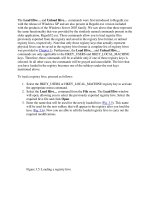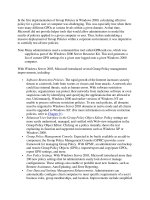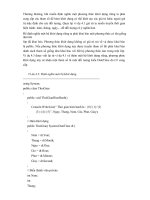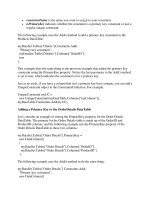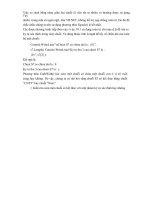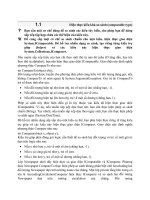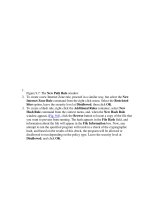OPTICAL IMAGING AND SPECTROSCOPY Phần 2 ppt
Bạn đang xem bản rút gọn của tài liệu. Xem và tải ngay bản đầy đủ của tài liệu tại đây (2.2 MB, 52 trang )
Figure 2.28 Base transmission pattern, tiled mask, and inversion deconvolution for p ¼ 5.
Figure 2.29 Base transmission pattern, tiled mask, and inversion deconvolution for p ¼ 11.
38
GEOMETRIC IMAGING
implemented under cyclic boundary conditions rather than using zero padding. In
contrast with a pinhole system, the number of pixels in the reconstructed coded aper-
ture image is equal to the number of pixels in the base transmission pattern.
Figures 2.31–2.33 are simulations of coded aperture imaging with the 59 Â 59-element
MURA code. As illustrated in the figure, the measured 59 Â 59-element data are
strongly positive. For this image the maximum noise-free measurement value is
100, and the minimum value is 58, for a measurement dynamic range of ,2. We
will discuss noise and entropic measures of sensor system performance at various
points in this text, in our first encounter with a multiplex measurement system we
simply note that isomorphic measurement of the image would produce a much
higher measurement dynamic range for this image.
In practice, noise sensitivity is a primary concern in coded aperture and other mul-
tiplex sensor systems. For the MURA-based coded aperture system, Gottesman and
Fenimore [102] argue that the pixel signal-to-noise ratio is
SNR
ij
¼
Nf
ij
ffiffiffiffiffiffiffiffiffiffiffiffiffiffiffiffiffiffiffiffiffiffiffiffiffiffiffiffiffiffiffiffiffiffiffiffiffiffiffiffiffiffiffiffiffiffiffiffiffiffiffi
Nf
ij
þ N
P
kl
f
kl
þ
P
kl
B
kl
p
(2:47)
where N is the number of holes in the coded aperture and B
kl
is the noise in the (kl)th
pixel. The form of the SNR in this case is determined by signal-dependent, or “shot,”
noise. We discuss the noise sources in electronic optical detectors in Chapter 5 and
Figure 2.30 Base transmission pattern, tiled mask, and inversion deconvolution for p ¼ 59.
2.5 PINHOLE AND CODED APERTURE IMAGING 39
Figure 2.31 Coded aperture imaging simulation with no noise for the 59 Â 59-element code
of Fig. 2.30.
Figure 2.32 Coded aperture imaging simulation with shot noise for the 59 Â 59-element
code of Fig. 2.30.
40
GEOMETRIC IMAGING
derive the square-root characteristic form of shot noise in particular. For the 59 Â 59
MURA aperture, N ¼ 1749. If we assume that the object consists of binary values 1
and 0, the maximum pixel SNR falls from 41 for a point object to 3 for an object with
200 points active. The smiley face object of Fig. 2.31 consists of 155 points.
Dependence of the SNR on object complexity is a unique feature of multiplex
sensor systems. The equivalent of Eqn. (2.47) for a focal imaging system is
SNR
ij
¼
Nf
ij
ffiffiffiffiffiffiffiffiffiffiffiffiffiffiffiffiffiffi
Nf
ij
þ B
ij
p
(2:48)
This system produces an SNR of approximately
ffiffiffiffi
N
p
independent of the number of
points in the object.
As with the canonical wave and correlation field multiplex systems presented
in Sections 10.2 and 6.4.2, coded aperture imaging provides a very high depth
field image but also suffers from the same SNR deterioration in proportion to
source complexity.
2.6 PROJECTION TOMOGRAPHY
To this point we have considered images as two-dimensional distributions, despite
the fact that target objects and the space in which they are embedded are typically
Figure 2.33 Coded aperture imaging simulation with additive noise for the 59 Â 59-element
code of Fig. 2.30.
2.6 PROJECTION TOMOGRAPHY 41
three-dimensional. Historically, images were two-dimensional because focal imaging
is a plane-to-plane transformation and because photochemical and electronic detector
arrays are typically 2D films or focal planes. Using computational image synthesis,
however, it is now common to form 3D images from multiplex measurements. Of
course, visualization and display of 3D images then presents new and different
challenges.
A variety of methods have been applied to 3D imaging, including techniques
derived from analogy with biological stereo vision systems and actively illuminated
acoustic and optical ranging systems. Each approach has advantages specific to tar-
geted object classes and applications. Ranging and stereo vision are best adapted
to opaque objects where the goal is to estimate a surface topology embedded in
three dimensions.
The present section and the next briefly overview tomographic methods for multi-
dimensional imaging. These sections rely on analytical techniques and concepts, such
as linear transform theory, the Fourier transform and vector spaces, which are not for-
mally introduced until Chapter 3. The reader unfamiliar with these concepts may find
it useful to read the first few sections of that chapter before proceeding. Our survey of
computed tomography is necessarily brief; detailed surveys are presented by Kak and
Slaney [131] and Buzug [37].
Tomography relies on a simple 3D extension of the density-based object model
that we have applied in this chapter. The word tomography is derived from the
Greek tomos, meaning slice or section, and graphia, meaning describing. The
word predates computational methods and originally referred to an analog technique
for imaging a cross section of a moving object. While tomography is sometimes used
to refer to any method for measuring 3D distributions (i.e., optical coherence
tomography; Section 6.5), computed tomography (CT) generally refers to the projec-
tion methods described in this section.
Despite our focus on 3D imaging, we begin by considering tomography of 2D
objects using a one-dimensional detector array. 2D analysis is mathematically
simpler and is relevant to common X-ray illumination and measurement hardware.
2D slice tomography systems are illustrated in Fig. 2.34. In parallel beam systems,
a collimated beam of X rays illuminates the object. The object is rotated in front of
the X-ray source and one-dimensional detector opposite the source measures the inte-
grated absoption along a line through the object for each ray component.
As always, the object is described by a density function f(x, y). Defining, as
illustrated in Fig. 2.35, l to be the distance of a particular ray from the origin,
u
to
be the angle between a normal to the ray and the x axis, and
a
to be the distance
along the ray, measurements collected by a parallel beam tomography system take
the form
gl,
u
ðÞ¼
ð
flcos
u
À
a
sin
u
, l sin
u
þ
a
cos
u
ðÞd
a
(2:49)
where g(l,
u
) is the Radon transform of f(x, y). The Radon transform is defined
for f [ L
2
(R
n
) as the integral of f over all hyperplanes of dimension n 2 1. Each
42 GEOMETRIC IMAGING
Figure 2.34 Tomographic sampling geometries.
Figure 2.35 Projection tomography geometry.
2.6 PROJECTION TOMOGRAPHY 43
hyperplane is defined by a surface normal vectori
n
[in Eqn. (2.49) i
n
¼ cos
u
i
x
þ sin
u
i
y
].
The equation of the hyperplane is x
.
i
n
¼ l. The Radon transform in R
n
may be expressed
R{f }(l, i
n
) ¼
ð
R
nÀ1
f (li
n
þ a)(d
a
)
nÀ1
(2:50)
where
a
is a vector in the hyperplane orthogonal to i
n
. With reference to the definition
given in Eqn. (3.10), the Fourier transform with respect to l of R{ f }(l, i
n
)is
F
l
R{ f }(l, i
n
)
fg¼
ðð
ð
^
f (u)e
2
p
uÁ li
n
þ
a
ðÞ
e
À2
p
iu
l
l
(d
a
)
nÀ1
(du)
n
dl
¼
^
f (u ¼ u
l
i
n
)(2:51)
Equation (2.51), relating the 1D Fourier transform of the Radon transform to the Fourier
transform sampled on a line parallel to i
n
, is called the projection slice theorem.
In the case of the Radon transform on R
2
, the Fourier transform with respect to l of
Eqn. (2.49) yields
^
gu
l
,
u
ðÞ¼
ðððð
g(l,
u
)e
Àj2
p
u
l
l
du dv dl d
a
(2:52)
¼
^
fu¼ u
l
cos
u
, v ¼ u
l
sin
u
ðÞ(2:53)
where f
ˆ
is the Fourier transform of f. If we sample uniformly in l space along an aper-
ture of length R
s
, then Du
l
¼ 2
p
/R
s
. The sample period along l determines the spatial
extent of the sample.
In principle, one could use Eqn. (2.52) to sample the Fourier space of the object
and then inverse-transform to estimate the object density. In practice, difficulties in
interpolation and sampling in the Fourier space make an alternative algorithm
more attractive. The alternative approach is termed convolution–backprojection.
The algorithm is as follows:
1. Measure the projections g(l,
u
).
2. Fourier-transform to obtain g
ˆ
(u
l
,
u
).
3. Multiply
^
g(u
l
,
u
) by the filter ju
l
j and inverse-transform. This step consists of
convolving g(l,
u
) with the inverse transformation of ju
l
j (the range of u
l
is
limited to the maximum frequency sampled). This step produces the filtered
function Q(l,
u
) ¼
Ð
ju
l
j
^
gu
l
,
u
ðÞexp (i2
p
u
l
l)du
l
.
4. Sum the filtered functions Q(l,
u
) interpolated at points l ¼ x cos
u
þ y sin
u
to
produce the reconstructed estimate of f. This constitutes the backprojection step.
To understand the filtered backprojection approach, we express the inverse Fourier
transform relationship
f (x, y) ¼
ðð
^
fu, vðÞe
i2
p
(uxþvy)
du dv (2:54)
44 GEOMETRIC IMAGING
in cylindrical coordinates as
f (x, y) ¼
ð
2
p
0
ð
1
0
^
fw,
u
ðÞe
i2
p
w(x cos
u
þy sin
u
)
wdwd
u
(2:55)
where w ¼
ffiffiffiffiffiffiffiffiffiffiffiffiffiffiffi
u
2
þ v
2
p
. Equation (2.55) can be rearranged to yield
f (x, y) ¼
ð
p
0
ð
1
0
^
fw,
u
ðÞe
i2
p
w(x cos
u
þy sin
u
)
À
þ
^
fw,
u
þ
p
ðÞe
Ài2
p
w(x cos
u
þy sin
u
)
Á
wdwd
u
(2:56)
¼
ð
p
0
ð
1
À1
^
fw,
u
ðÞe
i2
p
w(x cos
u
þy sin
u
)
jwjdw d
u
(2:57)
where we use the fact that for real-valued f(x, y),
^
f (w,
u
) ¼
^
f (Àw,
u
þ
p
). This
means that
f (x, y) ¼
ð
p
0
Q(l ¼ x cos
u
þ y sin
u
,
u
)d
u
(2:58)
The convolution–backprojection algorithm is illustrated in Fig. 2.36, which
shows the Radon transform, the Fourier transform
^
g(u
l
,
u
), the Fourier transform
^
f (u, v), Q(l,
u
), and the reconstructed object estimate. Note, as expected from the pro-
jection slice theorem, that
^
g(u
l
,
u
) corresponds to slices of
^
f (u, v ) “unrolled” around
the origin. Edges of the Radon transform are enhanced in Q(l,
u
), which is a “high-
pass” version of g(l,
u
).
We turn finally to 3D tomography, where we choose to focus on projections
measured by a camera. A camera measures a bundle of rays passing through a prin-
cipal point, (x
o
, y
o
, z
o
). For example, we saw in Section 2.5 that a pinhole or coded
aperture imaging captures
^
f (
u
x
,
u
y
), where, repeating Eqn. (2.31)
^
f (
u
x
,
u
y
) ¼
ð
f (z
o
u
x
, z
o
u
y
, z
o
)dz
o
(2:59)
f
ˆ
(
u
x
,
u
y
) is the integral of f(x, y, z) along a line through the origin of the (x
o
, y
o
, z
o
)
coordinate system. (
u
x
,
u
y
) are angles describing the direction of the line on the
unit sphere. In two dimensions, a system that collects rays through series of principal
points implements fan beam tomography. Fan beam systems often combine a point
x-ray source with a distributed array of detectors, as illustrated in Fig. 2.34.
In 3D, tomographic imaging using projections through a sequence of principal
points is cone beam tomography. Note that Eqn. (2.59) over a range of vertex
points is not the 3D Radon transform. We refer to the transformation based on projec-
tions along ray bundles as the X-ray transform. The X-ray transform is closely related
2.6 PROJECTION TOMOGRAPHY 45
to the Radon transform, however, and can be inverted by similar means. The 4D
X-ray transform of 3D objects, consisting of projections through all principal points
on a sphere surrounding an object, overconstrains the object. Tuy [233] des-
cribes reduced vertex paths that produce well-conditioned 3D X-ray transforms of
3D objects.
A discussion of cone beam tomography using optical imagers is presented
by Marks et al. [168], who apply the circular vertex path inversion algorithm
Figure 2.36 Tomographic imaging with the convolution–backprojection algorithm.
46
GEOMETRIC IMAGING
developed by Feldkamp et al. [68]. The algorithm uses 3D convolution–
backprojection based on the vertex path geometry and parameters illustrated
in Fig. 2.37. Projection data f
F
(
u
x
,
u
y
) are weighted and convolved with the separable
filters
h
y
(
u
y
) ¼
ð
v
yo
À
v
yo
d
v
j
v
jexp
i
vu
y
À 2j
v
j
v
yo
h
x
(
u
x
) ¼
sin(
u
x
v
zo
)
pu
z
(2:60)
where
v
yo
and
v
zo
are the angular sampling frequencies of the camera. These filters
produce the intermediate function
Q
F
(
u
x
,
u
y
) ¼
ðð
d
u
0
x
d
u
0
y
h
x
(
u
x
À
u
0
x
)h
y
(
u
y
À
u
0
y
)
f
F
(
u
0
x
,
u
0
y
)
ffiffiffiffiffiffiffiffiffiffiffiffiffiffiffiffiffiffiffiffiffiffi
1 þ
u
0
x
2
u
0
y
2
q
(2:61)
and the reconstructed 3D object density is
f
E
(x, y, z) ¼
1
4
p
2
ð
d
2
(d þ x cos
f
)
2
Q
f
y
d þ x cos
f
,
z sin
f
d þ x cos
f
!
d
f
(2:62)
2.7 REFERENCE STRUCTURE TOMOGRAPHY
Optical sensor design boils down to compromises between mathematically attractive
and physically attainable visibilities. In most cases, physical mappings are the starting
point of design. So far in this chapter we have encountered two approaches driven
Figure 2.37 Cone beam geometry.
2.7 REFERENCE STRUCTURE TOMOGRAPHY 47
primarily by ease of physical implementation (focal and tomographic imaging) and
one attempt to introduce artificial coding (coded aperture imaging). The tension
between physical and mathematical/coding constraints continues to develop in the
remainder of the text.
The ultimate challenge of optical sensor design is to build a system such that the
visibility v(A, B) is optimal for the sensor task. 3D optical design, specifying the
structure and composition of optical elements in a volume between the object and
detector elements, is the ultimate toolkit for visibility coding. Most current optical
design, however, is based on sequences of quasiplanar surfaces. In view of the ele-
gance of focal imaging and the computational challenge of 3D design, the planar/
ray-based approach is generally appropriate and productive. 3D design will,
however, ultimately yield superior system performance.
As a first introduction to the challenges and opportunities of 3D optics, we con-
sider reference structure tomography (RST) as an extension of coded aperture
imaging to multiple dimensions [30]. Ironically, to ease explanation and analysis,
our discussion of RST is limited to the 2D plane. The basic concept of a reference
structure is illustrated in Fig. 2.38. A set of detectors at fixed points observes a
radiant object through a set of reference obscurants. A ray through the object is
visible at a detector if it does not intersect an obscurant; rays that intersect obscurants
are not visible. The reference structure/detector geometry segments the object space
into discrete visibility cells. The visibility cells in Fig. 2.38 are indexed by signatures
x
i
¼ 1101001 ,wherex
ij
is one if the ith cell is visible to the jth detector and
zero otherwise.
Figure 2.38 Reference structure geometry.
48
GEOMETRIC IMAGING
As discussed in Section 2.1, the object signal may be decomposed into com-
ponents f
i
such that
f
j
¼
ð
cell
j
f (A)dA (2:63)
Measurements on the system are then of the form
g
i
¼
X
j
x
ij
f
j
(2:64)
As is Eqn. (2.4), Eqn. (2.64) may be expressed in discrete form as g ¼ Hf. In contrast
with coded aperture imaging, the RST mapping is shift variant and the measurements
are not embedded in a natural continuous space.
Interesting scaling laws arise from the consideration of RST systems consisting of
m detectors and n obscurants in a d-dimensional embedding space. The number of
possible signatures (2
m
) is much larger than the number of distinct visibility cells
(O(m
d
n
d
)). Agarwal et al. prove a lower bound of order (mn=log(n))
d
exists on the
minimum number of distinct signatures [2]. This means that despite the fact that
different cells have the same signature in Fig. 2.38, as the scale of the system
grows, each cell tends to have a unique signature.
The RST system might thus be useful as a point source location system, since a
point source hidden in (mn)
d
cells would be located in m measurements. Since an effi-
cient system for point source location on N cells requires log N measurements, RST is
efficient for this purpose only if m ( n. Point source localization may be regarded as
an extreme example of compressive sampling or combinatorial group testing. The
nature of the object is constrained, in this case by extreme sparsity, such that recon-
struction is possible with many fewer measurements than the number of resolution
cells. More generally, reference structures may be combined with compressive esti-
mation [38,58] to image multipoint sparse distributions on the object space.
Since the number of signature cells is always greater than m, the linear mapping
g ¼ Hf is always ill-conditioned. H is a m  p matrix, where p is the number of sig-
natures realized by a given reference structure. H may be factored into the product
H ¼ USV
y
by singular value decomposition (SVD). U and V are m  m and
p  p unitary matrices and S is a m Âp matrix with nonnegative singular values
along the diagonal and zeros off the diagonal.
Depending on the design of the reference structure and the statistics of the object,
one may find that the pseudoinverse
f
e
¼ VS
À1
U
y
g (2:65)
is a good estimate of f. We refer to this approach in Section 7.5 as projection of f onto
the range of H. The range of H is an m-dimensional subspace of the p-dimensional
2.7 REFERENCE STRUCTURE TOMOGRAPHY 49
space spanned by the state of the signature cells. The complement of this subspace in R
p
is the null space of H. The use of prior information, such as the fact that f consists of a
point source, may allow one to infer the null space structure of f from measurements in
the range of H. Brady et al. [30] take this approach a step further by assuming that f is
described by a continuous basis rather than the visibility cell mosaic.
Analysis of the measurement, representation, and analysis spaces requires more
mathematical tools than we have yet utilized. We develop such tools in the next
chapter and revisit abstract measurement strategies in Section 7.5.
PROBLEMS
2.1 Visibility
(a) Suppose that the half space x . 0 is filled with water while the half-space
x , 0 is filled with air. Show that the visibility v(A, B) ¼ 1 for all points
A and B [ R
3
.
(b) Suppose that the subspace l . x .21 is filled with glass (e.g., a window)
while the remainder of space is filled with air. Show that the visibility
v(A, B) ¼ 1 for all points A and B [ R
3
.
(c) According to Eqn. (2.5), the transmission angle
u
2
becomes complex for
(n
1
/n
2
)sin
u
1
. 1. In this case, termed total internal reflection, there is no
transmitted ray from region 1 into region 2. How do you reconcile the fact
that if n
1
. n
2
some rays from region 1 never penetrate region 2 with the
claim that all points in region 1 are visible to all points in region 2?
2.2 Materials Dispersion. The dispersive properties of a refractive medium are
often modeled using the Sellmeier equation
n
2
(
l
) ¼ 1 þ
B
1
l
2
l
2
À C1
þ
B
2
l
2
l
2
À C2
þ
B
3
l
2
l
2
À C3
(2:66)
The Sellmeier coefficients for Schott glass type SF14 are given in Table 2.1.
(a) Plot n(
l
) for SF14 for
l
¼ 400–800 nm.
(b) For
u
?1
¼
p
=8,
u
?2
¼À
p
=8, and
u
a
¼À
p
=16, plot
u
b
as a function of
l
over the range 400–800 nm for an SF14 prism.
TABLE 2.1 Dispersion Coefficients of SF14 Glass
B
1
1.69182538
B
2
0.285919934
B
3
1.12595145
C
1
0.0133151542
C
2
0.0612647445
C
3
118.405242
50
GEOMETRIC IMAGING
2.3 Microscopy. A modern microscope using an infinity-corrected objective
forms an intermediate image at a distance termed the reference focal length.
What is the magnification of the objective in terms of the reference focal
length and the objective focal length?
2.4 Telescopy. Estimate the mass of a 1-m aperture 1-m focal length glass refrac-
tive lens. Compare your answer with the mass of a 1-m aperture mirror.
2.5 Ray Tracing. Consider an object placed 75 cm in front a 50-cm focal length
lens. A second 50-cm focal length lens is placed 10 cm behind the first.
Sketch a ray diagram for this system, showing the intermediate and final
image planes. Is the image erect or inverted, real or virtual? Estimate the
magnification.
2.6 Paraxial Ray Tracing. What is the ABCD matrix for a parabolic mirror? What
is the ray transfer matrix for a Cassegrain telescope? How does the magnifi-
cation of the telescope appear in the ray transfer matrix?
2.7 Spot Diagrams. Consider a convex lens in the geometry of Fig. 2.10.
Assuming that R
1
¼ R
2
¼ 20 cm and n ¼ 1.5, write a computer program to
generate a spot diagram in the nominal thin lens focal plane for parallel rays
incident along the z axis. A spot diagram is a distribution of ray crossing
points. For example, use numerical analysis to find the point that a ray incident
on the lens at point (x, y) crosses the focal plane. Such a ray hits the first
surface of the lens at point z ¼ (x
2
þ y
2
)/2R
1
2 d
1
and is refracted onto a
new ray direction. The refracted ray hits the second surface at the point such
that (x, y, z) þ Ci
t1
satisfies z ¼ d
2
À (x
2
þ y
2
)=2R
1
. The ray is refracted
from this point toward the focal plane. Plot spot diagrams for the refracted
rays for diverse input points at various planes near the focal plane to
attempt to find the plane of best focus. Is the best focal distance the same as
predicted by Eqn. (2.16)? What is the area covered by your tightest spot
diagram? (Hint: Since the lens is rotationally symmetric and the rays are inci-
dent along the axis, it is sufficient to solve the ray tracing problem in the xz
plane and rotate the 1D spot diagram to generate a 2D diagram.)
2.8 Computational Ray Tracing. Automated ray tracing software is the workhorse
of modern optical design. The goal of this problem is to write a ray tracing
program using a mathematical programming environment (e.g., Matlab or
Mathematica). For simplicity, work with rays confined to the xz plane. In a
2D ray tracing program, each ray has a current position in the plane and a
current unit vector. To move to the next position, one must solve for the inter-
cept at which the ray hits the next surface in the optical system. One draws a
line from the current position to the next position along the current direction
and solves for the new unit vector using Snell’s law. Snell’s law at any
surface in the plane is
n
1
i
i
 i
n
¼ n
2
i
t
 i
n
(2:67)
PROBLEMS 51
where i
i
is a unit vector along the incident ray, i
t
is a unit vector along the
refracted ray and i
n
is a unit vector parallel to the surface normal. Given i
i
and i
n
, one solves for i
t
using Snell’s law and the normalization condition.
The nth surface is defined by the curve F
n
(x, z) ¼ 0 and the normal at
points on the surface is
@F
n
@x
i
x
þ
@F
n
@z
i
z
(2:68)
which one must normalize to obtain i
n
. As an example, Fig. 2.39 is a ray
tracing plot for 20 rays normally incident on a sequence of lenses. The
index of refraction of each lens is 1.3. The nth surface is described by
z ¼ nD þ
k
(x À
a
)(x þ
a
)x
2
(2:69)
for n even and
z ¼ (n À 1)D þ
d
À
k
(x À
a
)(x þ
a
)x
2
(2:70)
for n odd. In Fig. 2.39,
k
¼ 1/2500,
a
¼ 10, D ¼ 4, and d ¼ 1. (Notice
that ray tracing does not require specification of spatial scale. See Section
10.4.1 for a discussion of scale and ray tracing.) Write a program to trace
rays through an arbitrary sequence of surfaces in the 2D plane. Demonstrate
the utility of your program by showing ray traces through three to five
Figure 2.39 Ray tracing through arbitrary lenses.
52
GEOMETRIC IMAGING
lenses satisfying the general form of Eqn. (2.69) for various values of
a
,
k
, d,
and D.
2.9 Pinhole Visibility. Derive the geometric visibility for a pinhole camera [Eqn.
(2.25)].
2.10 Coded Aperture Imaging. Design and simulate a coded aperture imaging
system using a MURA mask. Use a mask with 50 or more resolution cells
along each axis.
(a) Plot the transmission mask, the decoding matrix, and the cross-correlation
of the two.
(b) Simulate reconstruction of an image of your choice, showing both the
measured data and its reconstruction using the MURA decoding matrix.
(c) Add noise to your simulated data in the form of normal and Poisson
distributed values at various levels and show reconstruction using the
decoding matrix.
(d) Use inverse Fourier filtering to reconstruct the image (using the FFT of the
mask as an inverse filter). Plot the FFT of the mask.
(e) Submit your code, images and a written description of your results.
2.11 Computed Tomography
(a) Plot the functions f
1
(x, y) ¼rect(x)rect(y)andf
2
(x, y) ¼rect(x)rect(y)(1 2
rect(x þ y)rect(x 2 y)).
(b) Compute the Radon transforms of f
1
(x, y) and f
2
(x, y) numerically.
(c) Use a numerical implementation of the convolution–backprojection tech-
nique described in Section 2.6 to estimate f
1
(x, y) and f
2
(x, y) from their
Radon transforms.
2.12 Reference Structure Tomography. A 2D reference structure tomography
system as sketched in Fig. 2.38 modulates the visibility of an object embed-
ding space using n obscuring disks. The visibility is observed by m detectors.
(a) Present an argument justifying the claim that the number of signature cells
is of order m
2
n
2
.
(b) Assuming prior knowledge that the object is a point source, estimate the
number of measurements necessary to find the signature cell occupied by
the object.
(c) For what values of m and n would one expect a set of measurements to
uniquely identify the signature cell occupied by a point object?
PROBLEMS 53
3
ANALYSIS
the electric forces can disentangle themselves from material bodies and can continue
to subsist as conditions or changes in the state of space.
—H. Hertz [118]
3.1 ANALYTICAL TOOLS
Chapter 2 developed a geometric model for optical propagation and detection and
described algorithms for object estimation on the basis of this model. While
geometric analysis is of enormous utility in analysis of patterns formed on image
or projection planes, it is less useful in analysis of optical signals at arbitrary
points in the space between objects and sensors. Analysis of the optical system at
all points in space requires the concept of “the optical field.” The field describes
the state of optical phenomena, such as spectra, coherence, and polarization par-
ameters, independent of sources and detectors.
Representation, analysis, transformation, and measurement of optical fields are the
focus of the next four chapters. The present chapter develops a mathematical frame-
work for analysis of the field from the perspective of sensor systems. A distinction
may be drawn between optical systems, such as laser resonators and fiber waveguides,
involving relatively few spatial channels and systems, such as imagers and spec-
trometers, involving a large number of degrees of freedom. The degrees of freedom
are typically typically expressed as pixel values, modal amplitudes or Fourier com-
ponents. It is not uncommon for a sensor system to involve 10
6
210
12
parameters.
To work with such complex fields, this chapter explores mathematical tools
drawn from harmonic analysis. We begin to apply these tools to physical field analysis
in Chapter 4.
Optical Imaging and Spectroscopy. By David J. Brady
Copyright # 2009 John Wiley & Sons, Inc.
55
We develop two distinct sets of mathematical tools:
1. Transformation tools, which enable us to analyze propagation of fields from
one space to another
2. Sampling tools, which enable us to represent continuous field distributions
using discrete sets of numbers
A third set of mathematical tools, signal encoding and estimation from sample data, is
considered in Chapters 7 and 8.
This chapter initially considers transformation and sampling in the context of
conventional Fourier analysis, meaning that transformations are based on Fourier
transfer functions and impulse response kernels and sampling is based on the
Whittaker–Shannon sampling theorem. Since the mid-1980s, however, dramatic dis-
coveries have revolutionized harmonic signal analysis. New tools drawn from
wavelet theory allow us to compare various mathematical models for fields, includ-
ing different classes of functions (plane waves, modes, and wavelets) that can be
used to represent fields. Different mathematical bases enable us to flexibly distribute
discrete components to optimize computational processing efficiency in field
analysis.
Section 3.2 broadly describes the nature of fields and field transformations.
Sections 3.3–3.5 focus on basic properties of Fourier and Fresnel transformations.
We consider conventional Shannon sampling in Section 3.6. Section 3.7 discusses
discrete numerical analysis of linear transformations. Sections 3.8–3.10 briefly
extend sampling and discrete transformation analysis to include wavelet analysis.
3.2 FIELDS AND TRANSFORMATIONS
A field is a distribution function defined over a space, meaning that a field value is
associated with every point in the space. The optical field is a radiation field,
meaning that it propagates through space as a wave. Propagation induces relationships
between the field at different points in space and constrains the range of distribution
functions that describe physically realizable fields.
Optical phenomena produce a variety of observables at each point in the
radiation space. The “data cube” of all possible observables at all points is a
naive representation of the information encoded on the optical signal. Well-
informed characterization of the optical signal in terms of signal values at discrete
points, modal applitudes, or boundary conditions greatly reduces the complexity of
representing and analyzing the field. Our goal in this chapter is to develop the
mathematical tools that enable efficient analysis. While our discussion is often
abstract, it is important to remember that the mathematical distributions are tied
to physical observables. On the other hand, this association need not be parti-
cularly direct. We often find it useful to use field distributions that describe func-
tions that are not directly observable in order to develop system models for
ultimately observable phenomena.
56 ANALYSIS
The state of the optical field is described using distributions defined over various
spaces. The most obvious space is Euclidean space–time, R
3
 T, and the most
obvious field distribution is the electric field E(r, t). The optical field cannot be an
arbitrary distribution because physical propagation rules induce correlations
between points in space–time. For the field independent of sources and detectors,
these relationships are embodied in the Maxwell equations discussed in Chapter 4.
The quantum statistical nature of optical field generation and detection is most
easily incorporated in these relationships using the coherence theory developed in
Chapter 6.
System analysis using field theory consists of the use of physical relationships
to determine the field in a region of space on the basis of the specification of the
field in a different region. The basic problem is illustrated in Fig. 3.1. The field is
specified in one region, such as the (x, y) plane illustrated in the figure. This
plane may correspond to the surface of an object or to an aperture through which
object fields propagate. Given the field on an input boundary, we combine mathemat-
ical tools from this chapter with physical models from Chapter 4 to estimate the
field elsewhere. In Fig. 3.1, the particular goal is to find the field on the output
(x
0
, y
0
) plane.
Mathematically, propagation of the field from the input boundary to an output
boundary may be regarded as a transformation from a distribution f(x, y, t) on the
input plane to a distribution g(x
0
, y
0
, t) on the output plane. For optical fields this trans-
formation is linear.
We represent propagation of the field from one boundary to another by the
transformation g(x
0
, y
0
) ¼ Tff(x, y)g. The transformation Tf
.
g is linear over its
functional domain if for all functions f
1
(x, y)andf
2
(x, y) in the domain and for all
scalars
a
and
b
T {
a
f
1
(x) þ
b
f
2
(x)} ¼
a
T {f
1
(x)} þ
b
T{f
2
(x)} (3:1)
Figure 3.1 Plane-to-plane transformation of optical fields.
3.2 FIELDS AND TRANSFORMATIONS 57
Linearity allows transformations to be analyzed using superpositions of basis functions.
A function f(x, y) in the range of a discrete basis f
f
n
(x, y)g may be expressed
f (x, y) ¼
X
n
f
n
f
n
(x, y)(3:2)
This chapter explores several potential basis functions
f
n
. The advantage of this
approach is the effect of a linear transformation on the basis functions is easily
mapped onto transformations of arbitrary input distributions by algebraic methods.
Linearity implies that
T{f (x, y)} ¼
X
n
f
n
T{
f
n
(x, y)} (3:3)
For the discrete representation of Eqn. (3.2), the range of the transformation is also
spanned by a discrete basis
c
m
(x, y) such that
T{
f
n
(x, y)} ¼
X
m
h
nm
c
m
(x, y)(3:4)
Representing the input function f(x, y) by a vector of discrete coefficients f ¼ ff
n
gand
the output function g(x
0
, y
0
) by a vector of discrete coefficients g ¼ fg
m
g such that
g(x
0
, y
0
) ¼
X
m
g
m
c
m
(x, y)(3:5)
linearity allows us to express the transformation algebrically as g ¼ Hf, where the
coefficients of H are h
nm
.
Similar representations of a linear transformation may be developed for functions
represented on continuously indexed bases. The simplest example builds on the Dirac
d
function. The input distribution is represented on the
d
function basis as
f (x, y) ¼
ðð
f (x
0
, y
0
)
d
(x À x
0
, y À y
0
)dx
0
dy
0
(3:6)
Using the
d
function basis an arbitrary linear transformation may be expressed in
integral form by noting
T{f (x, y)} ¼ T
ðð
f (x
0
, y
0
)
d
(x Àx
0
, y À y
0
) dx
0
dy
0
¼
ðð
f (x
0
, y
0
)T{
d
(x Àx
0
, y À y
0
)}dx
0
dy
0
¼
ðð
f (x
0
, y
0
)h(x
00
, x
0
, y
00
, y
0
) dx
0
dy
0
(3:7)
where h(x
00
, x
0
, y
00
, y
0
) ¼ Tfd(x 2 x
0
, y 2 y
0
)g is the impulse response associated with
the transformation Tf
.
g.
58 ANALYSIS
Harmonic bases are particularly useful in the analysis of shift-invariant linear
transformations. Letting g(x
0
, y
0
) ¼ Tff(x, y)g, Tf
.
g is shift-invariant if
T{f (x Àx
o
, y À y
o
)} ¼ g(x
0
À x
o
, y
0
À y
o
)(3:8)
The impulse response of a shift-invariant transformation takes the form h(x
0
, x
0
,
y
0
, y
0
) ¼ h(x
0
2 x, y
0
2 y) and the integral representation of the transformation is
the convolution
g(x
0
, y
0
) ¼ T{f (x, y)} ¼
ðð
f (x, y)h(x
0
À x, y
0
À y)dx dy (3:9)
Shift invariance means that shifts in the input distribution produce identical shifts in
the output distribution. Imaging systems are often approximately shift-invariant after
accounting for magnification, distortion, and discrete sampling.
Optical field propagation can usually be modeled as a linear transformation and
can sometimes be modeled as a shift-invariant linear transformation. Shift invariance
applies in imaging and diffraction in homogeneous media, where a shift in the input
object produces a corresponding shift in the output image or diffraction pattern. Shift
invariance does not apply to diffraction or refraction through structured optical scat-
terers or devices. Recalling, for example, field propagation through reference struc-
tures from Section 2.7, one easily sees that shift in the object field produces a
complex shift-variant recoding of the object shadow.
3.3 FOURIER ANALYSIS
Fourier analysis is a powerful tool for analysis of shift-invariant systems. Since shift-
invariant imaging and field propagation are central to optical systems, Fourier analy-
sis is ubiquitous in this text. The attraction is that Fourier analysis allows the response
of a linear shift-invariant system to be modeled by a multiplicative transfer function
( filter). Fourier analysis also arises naturally as an explanation of resonance and color
in optical cavities and quantum mechanical interactions. One might say that Fourier
analysis is attractive because optical propagation is linear and because field–matter
interactions are nonlinear.
Fourier transforms take slightly different forms in different texts; here we represent
the Fourier transform f
ˆ
(u) of a function f(x) [ L
2
(R)as
^
f (u) ¼
ð
1
À1
f (x)e
À2
p
ixu
dx (3:10)
with inverse transformation
f (x) ¼
ð
1
À1
^
f (u)e
2
p
ixu
du (3:11)
3.3 FOURIER ANALYSIS 59
In optical system analysis one often has recourse to multidimensional Fourier trans-
forms, which one defines for f [ L
2
(R
n
)as
^
f (u
1
, u
2
, u
3
ÁÁÁ) ¼
ð
1
À1
ð
1
À1
ð
1
À1
f (x
1
, x
2
, x
3
)P
j
e
À2
p
ix
j
u
dx
j
(3:12)
Useful identities associated with the one-dimensional Fourier transformation include
1. Differentiation
F
df (x)
dx
¼ 2
p
iu
^
f (u)(3:13)
and
F
À1
d
^
f (u)
du
()
¼À2
p
ixf (x)(3:14)
2. Translation
F{f (x Àx
o
)} ¼ e
À2
p
ix
o
u
^
f (u)(3:15)
3. Dilation. For real a = 0
F{f (ax)} ¼
1
jaj
^
f
u
a
(3:16)
4. Convolution
F f (x)g(x)
fg
¼
ð
1
À1
^
f (u
0
)
^
g(u Àu
0
)du
0
(3:17)
and
F
ð
1
À1
f (x
0
)g(x Àx
0
)dx
0
8
<
:
9
=
;
¼
^
f (u)
^
g(u)(3:18)
5. Plancherel’s theorem. kf(x)k ¼ kf
ˆ
(u)k, for example
ð
1
À1
j
^
f (u)j
2
du ¼
ð
1
À1
jf (x)j
2
dx (3:19)
60 ANALYSIS
Plancherel’s theorem is easily extended to show that for functions f(x) [ L
2
(R)
and g(x) [ L
2
(R)
ð
1
À1
^
f
Ã
(u)
^
g(u) du ¼
ð
1
À1
f
Ã
(x)g(x)dx (3:20)
6. Localization. Defining
m
f
¼
1
jjf jj
2
ð
1
À1
xjf (x)j
2
dx (3:21)
s
2
f
¼
1
jjf jj
2
ð
1
À1
(x À
m
f
)
2
jf (x)j
2
dx (3:22)
m
^
f
¼
1
jj
^
f jj
2
ð
1
À1
uj
^
f (u)j
2
du (3:23)
and
s
2
^
f
¼
1
jj
^
f jj
2
ð
1
À1
(u À
m
^
f
)
2
j
^
f (u)j
2
du (3:24)
we find
s
2
f
s
2
^
f
!
1
16
p
2
(3:25)
Equation (3.25) is often referred to as the uncertainty relationship, is the basis for the
Heisenberg uncertainty relationship of quantum mechanics. It describes the impossi-
bility of simultaneous signal localization in both the spatial and spectral regimes.
Proof of Eqn. (3.25) begins by noting that we can set
m
f
¼ 0 without loss of gen-
erality because by Eqn. (3.15) we know jf
ˆ
(u)j to be invariant under translation of the
x axis. We then find that
s
2
f
s
2
^
f
¼
1
jjf jj
2
jj
^
f jj
2
ð
1
À1
ð
1
À1
x
2
jf (x)j
2
(u À
m
^
f
)
2
j
^
f (u)j
2
dx du (3:26)
3.3 FOURIER ANALYSIS 61
Combining Eqns. (3.14) and (3.19), we note that
ð
1
À1
j2
p
ixf (x)j
2
dx ¼
ð
1
À1
d
^
f (u)
du
2
du (3:27)
and
s
2
f
s
2
^
f
¼
1
4
p
2
1
jjf jj
2
jj
^
f jj
2
ð
1
À1
ð
1
À1
u
2
d
^
f (u
0
)
du
2
j
^
f (u þ
m
^
f
)j
2
du
0
du (3:28)
To simplify Eqn. (3.28), we note that an inner product ka j bl, where a and b
are functions in L
2
fRg may be defined
hajbi¼
ð
1
À1
a
Ã
(x)b(x)dx (3:29)
In terms of this inner product, Eqn. (3.28) takes the form
s
2
f
s
2
^
f
¼
1
4
p
2
(d
^
f =du)j(d
^
f =du)
hu
^
f ju
^
f i
h f jf ih
^
f j
^
f i
(3:30)
Proof of the inner product identity [ka j alkb jbl] !jka jblj
2
is straightforward.
Applying this identity to Eqn. (3.30) yields
s
2
f
s
2
^
f
!
1
4
p
2
d
^
f
du
ju
^
f
*+
2
hf jf ih
^
f j
^
f i
(3:31)
For a function f
ˆ
(u)inL
2
fRg integration of
du
^
f
2
du
¼
^
f
2
þ u
^
f
Ã
d
^
f
du
þ u
^
f
d
^
f
Ã
du
(3:32)
yields
2<
d
^
f
du
ju
^
f
*+()
¼Àh
^
f j
^
f i (3:33)
62 ANALYSIS
Noting that
d
^
f
du
ju
^
f
*+
2
! <
d
^
f
du
ju
^
f
*+()
2
¼
h
^
f j
^
f i
4
(3:34)
we find
s
2
f
s
2
^
f
!
1
16
p
2
(3:35)
Proof that Eqn. (3.35) is an equality for
f (x) ¼ ae
Àb(xÀx
o
)
2
(3:36)
is left as an exercise.
Properties 1–6 extend trivially to multidimensional Fourier transforms. Properties
related to coordinate transformations are unique to multidimensional systems,
however. In two dimensions, we may consider the effect of rotation as an example.
Rotation in Two Dimensions The two-dimensional Fourier transform is
^
f (u, v) ¼
ð
1
À1
ð
1
À1
f (x, y)e
À2
p
i(xuþyv)
dx dy (3:37)
Under the rotation
x
0
y
0
¼
cos
u
sin
u
Àsin
u
cos
u
x
y
(3:38)
we find that
F{ f (x
0
, y
0
)} ¼
^
f (u cos
u
þ v sin
u
, v cos
u
À u sin
u
)(3:39)
Cylindrical Coordinates Analysis of the Fourier transform in other coordinate
systems is also of interest. In optical systems with a well-defined axis of propagation,
cylindrical coordinates are of particular interest. In cylindrical coordinates the two-
dimensional Fourier transformation is
^
f (u,
^
u
) ¼
ð
1
0
ð
p
À
p
f (
r
,
u
)e
À2
p
i
r
u cos (
u
À
^
u
)
r
d
r
d
u
(3:40)
3.3 FOURIER ANALYSIS 63
